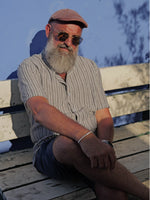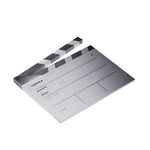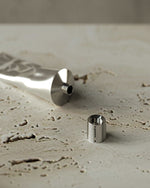20.09.23 in ambassadeurs
emil humbert and christophe poyet


Emil Humbert and Christophe Poyet are two French architects who founded their agency Humbert & Poyet in 2007. They share the same passion for creating timeless and elegant interiors and attach great importance to details, finishes and play of materials and textures.
how do you present yourself when you talk about yourself and your job?
emil humbert: I usually introduce myself as an architect, since I am an architect by training, but this title ultimately remains quite generic. At the agency, in fact, our field of activity is quite vast. We also do design, interior architecture, decoration, scenography, a little landscaping, and we even do furniture and fabric design.
christophe poyet: with emil, we have a fairly complementary background since for my part, I trained as an interior designer and I present myself as such. At the agency, we attach a lot of importance to detail in decoration. Each of our inspirations are totally convergent on a daily basis.
Have design and architecture always been obvious to you? A few words about your journey?
Emil Humbert: For me, architecture has always been an obvious field. I began my architectural studies with a strong sensitivity to art without really having identified what my talent was. This passion truly developed and refined throughout my studies which lasted several years.
Christophe Poyet: For my part, it was a little more vague, at least before starting these studies. I knew I wanted to pursue an artistic career, but without really having identified precisely which one. Ceramics, visual arts and photography interested me a lot. A bit like Emil, it was during my studies that this vocation was revealed and that I realized that I had real pleasure in doing this job.
And how did your association come about?
Christophe Poyet: Mutual friends introduced us. They were also architects, interior designers, and decorators. We've known each other for 15 years now and created the agency. Right away, there was chemistry between Emil and I, from day one, from the first time we met. We had this common desire straight away, that of trying to work on a first project which went very well. Afterwards, little by little, everything became very smooth.
Emil Humbert: What is interesting about our association is that I started working alone for 2 years, but I did not feel accomplished in my work. I needed to work as a team. It was really a need and I think it’s something that also connects us both. Between two people, there really is this exchange aspect in the service of the project and in the service of the idea. Our way of working, almost four hands, allowed us to create together the identity of the agency and our common style.
how do you present yourself when you talk about yourself and your job?
emil humbert: I usually introduce myself as an architect, since I am an architect by training, but this title ultimately remains quite generic. At the agency, in fact, our field of activity is quite vast. We also do design, interior architecture, decoration, scenography, a little landscaping, and we even do furniture and fabric design.
christophe poyet: with emil, we have a fairly complementary background since for my part, I trained as an interior designer and I present myself as such. At the agency, we attach a lot of importance to detail in decoration. Each of our inspirations are totally convergent on a daily basis.
Have design and architecture always been obvious to you? A few words about your journey?
Emil Humbert: For me, architecture has always been an obvious field. I began my architectural studies with a strong sensitivity to art without really having identified what my talent was. This passion truly developed and refined throughout my studies which lasted several years.
Christophe Poyet: For my part, it was a little more vague, at least before starting these studies. I knew I wanted to pursue an artistic career, but without really having identified precisely which one. Ceramics, visual arts and photography interested me a lot. A bit like Emil, it was during my studies that this vocation was revealed and that I realized that I had real pleasure in doing this job.
And how did your association come about?
Christophe Poyet: Mutual friends introduced us. They were also architects, interior designers, and decorators. We've known each other for 15 years now and created the agency. Right away, there was chemistry between Emil and I, from day one, from the first time we met. We had this common desire straight away, that of trying to work on a first project which went very well. Afterwards, little by little, everything became very smooth.
Emil Humbert: What is interesting about our association is that I started working alone for 2 years, but I did not feel accomplished in my work. I needed to work as a team. It was really a need and I think it’s something that also connects us both. Between two people, there really is this exchange aspect in the service of the project and in the service of the idea. Our way of working, almost four hands, allowed us to create together the identity of the agency and our common style.
“at the agency, we also do design, interior architecture, decoration, scenography, a little landscaping, and we even do furniture and fabric design. »


Who are the people or projects that, according to you, constitute references?
emil humbert: For my part, there were several triggers when I discovered the work of the architect Carlo Scarpa. The combination of different materials, the use of light, the raw side, and above all, the work with materials in interior architecture and its somewhat dramatic staging of the projects.
christophe poyet: More than an architect's reference, I would say for me that it is more periods of architecture which constitute a reference. The art deco period and the 30s and 40s were, and still are today, a great inspiration in our work. Also the great Italian decorators and artists of the 1950s. Gio Ponti, Carlo Mollino, and so many others… these are references that we have in common.
What would you like people to say about you or your work years from now?
emil humbert: It would really be a compliment if our projects were later seen as classics, things that stand the test of time and as timeless projects.
christophe poyet: I think that timelessness, which Emil evokes, is really a word that comes up often, even in conversations between us. Since the beginning, we have really tried to design projects with fairly timeless lines. I spoke previously about the decorative arts; we find a certain timelessness in the drawings and creations of this period. When sometimes customers come to us and tell us that they like this timeless side, it's a real compliment!
What compliment resonates most with you about your work as an architect?
Emil Humbert & Christophe Poyet: The best compliments come, I believe, from our clients when they express to us their first feelings upon discovering the completed project. There are not necessarily words about the work as such, but a real emotion. It's the most touching.
Any favorite themes in your creative approach?
Emil Humbert & Christophe Poyet: Our style is inspired by many different eras. We like to say that we have a style that refuses nothing and that is inspired by neoclassical, art deco, or even the 50s. We like to mix a little bit of all these styles for our projects and creations. There are always elements of design or interior architecture that will awaken something in the collective unconscious.
emil humbert: For my part, there were several triggers when I discovered the work of the architect Carlo Scarpa. The combination of different materials, the use of light, the raw side, and above all, the work with materials in interior architecture and its somewhat dramatic staging of the projects.
christophe poyet: More than an architect's reference, I would say for me that it is more periods of architecture which constitute a reference. The art deco period and the 30s and 40s were, and still are today, a great inspiration in our work. Also the great Italian decorators and artists of the 1950s. Gio Ponti, Carlo Mollino, and so many others… these are references that we have in common.
What would you like people to say about you or your work years from now?
emil humbert: It would really be a compliment if our projects were later seen as classics, things that stand the test of time and as timeless projects.
christophe poyet: I think that timelessness, which Emil evokes, is really a word that comes up often, even in conversations between us. Since the beginning, we have really tried to design projects with fairly timeless lines. I spoke previously about the decorative arts; we find a certain timelessness in the drawings and creations of this period. When sometimes customers come to us and tell us that they like this timeless side, it's a real compliment!
What compliment resonates most with you about your work as an architect?
Emil Humbert & Christophe Poyet: The best compliments come, I believe, from our clients when they express to us their first feelings upon discovering the completed project. There are not necessarily words about the work as such, but a real emotion. It's the most touching.
Any favorite themes in your creative approach?
Emil Humbert & Christophe Poyet: Our style is inspired by many different eras. We like to say that we have a style that refuses nothing and that is inspired by neoclassical, art deco, or even the 50s. We like to mix a little bit of all these styles for our projects and creations. There are always elements of design or interior architecture that will awaken something in the collective unconscious.
“the art deco period and the 30s and 40s were, and still are today, a great inspiration in our work. Also the great Italian decorators and artists of the 1950s. Gio Ponti, Carlo Mollino, and so many others…”

What style defines you?
Emil Humbert & Christophe Poyet: Flamboyant is an adjective that comes up often. Besides, it’s not necessarily a qualifier that comes from us. We hear it during interviews with journalists who tell us this, even adding a notion of “glamor” sometimes. somewhere, this corresponds to us and defines us quite well!
it's sometimes difficult to step back and define our own style. But it’s true that over the years and projects, this style has undoubtedly been refined and clarified. Let's say he's a little Franco-Italian. We have a lot of Italian references in our projects. We also have a lot of Italians in the team.
What are your favorite materials, shapes or patterns?
Emil Humbert & Christophe Poyet: We use noble materials in general, and we like alloys of different materials. We draw a lot of details and we like to highlight a material or material in our projects by incorporating another material or another material. It is often metal. Brass or nickel is used to highlight a stone, wood, or tree species, in particular with inserts in frames or in the form of details. We don't really have a favorite subject. I think we like to reinvent ourselves in our projects and not reapply the same formula systematically, but we like to work on material effects, juxtapositions of tactile properties too and of shine and dullness, and sometimes even within the same material. For us, these are things that are very important to make the project and the objects come alive.
Your biggest challenge achieved or to be achieved?
Emil Humbert & Christophe Poyet: Our biggest challenge is to maintain this consistency with today a large team. Humbert&Poyet has almost become a brand and the challenge is to succeed in carrying it on a daily basis and to continue with a growing team and all that this implies in terms of project management, team management and time management between our private life and our professional life.
If you weren't architects, what jobs would you do?
emil humbert: I would say landscaper for me. I love gardens and I especially love going out to choose and buy trees or plants. I could spend hours in huge nurseries looking at trees and projecting them into this or that space.
Christophe Poyet: I would say ceramist. I was doing plastic arts and ceramics classes in Monaco and it was really something that fascinated me, where I loved creating. There was a universe that I liked, the concentration, the smell of clay and the fact of being alone with the material.
Emil Humbert & Christophe Poyet: Flamboyant is an adjective that comes up often. Besides, it’s not necessarily a qualifier that comes from us. We hear it during interviews with journalists who tell us this, even adding a notion of “glamor” sometimes. somewhere, this corresponds to us and defines us quite well!
it's sometimes difficult to step back and define our own style. But it’s true that over the years and projects, this style has undoubtedly been refined and clarified. Let's say he's a little Franco-Italian. We have a lot of Italian references in our projects. We also have a lot of Italians in the team.
What are your favorite materials, shapes or patterns?
Emil Humbert & Christophe Poyet: We use noble materials in general, and we like alloys of different materials. We draw a lot of details and we like to highlight a material or material in our projects by incorporating another material or another material. It is often metal. Brass or nickel is used to highlight a stone, wood, or tree species, in particular with inserts in frames or in the form of details. We don't really have a favorite subject. I think we like to reinvent ourselves in our projects and not reapply the same formula systematically, but we like to work on material effects, juxtapositions of tactile properties too and of shine and dullness, and sometimes even within the same material. For us, these are things that are very important to make the project and the objects come alive.
Your biggest challenge achieved or to be achieved?
Emil Humbert & Christophe Poyet: Our biggest challenge is to maintain this consistency with today a large team. Humbert&Poyet has almost become a brand and the challenge is to succeed in carrying it on a daily basis and to continue with a growing team and all that this implies in terms of project management, team management and time management between our private life and our professional life.
If you weren't architects, what jobs would you do?
emil humbert: I would say landscaper for me. I love gardens and I especially love going out to choose and buy trees or plants. I could spend hours in huge nurseries looking at trees and projecting them into this or that space.
Christophe Poyet: I would say ceramist. I was doing plastic arts and ceramics classes in Monaco and it was really something that fascinated me, where I loved creating. There was a universe that I liked, the concentration, the smell of clay and the fact of being alone with the material.
“we like alloys of different materials. we draw a lot of details and we like to highlight a material or material in our projects by incorporating another material or another material. In fact, it is often metal. »

Which city inspires you or resembles you the most?
emil humbert: Paris is the city where I was born, which has always inspired me and which really built me in spite of myself. Without really realizing it. I undoubtedly owe this reference baggage a lot to Paris, which I explored until I was 20.
christophe poyet: I think that for me, it’s Rome. It's a city I've been to several times and each time, I find that there is heritage everywhere. A bit like in Paris. But there, there is also the side of sunshine, greenery and the Mediterranean – my roots – which Paris lacks. I have Italian roots through my grandparents and it's true that I am very close to Italy.
What is the gift you would like to receive soon?
emil humbert: It's not a gift strictly speaking, but I really like flowers, so I love being given them.
I especially love ranunculus and lilies. I have it at home all the time because it smells really good.
christophe poyet: A gift that always makes me very happy is ceramics, whether vintage or contemporary. People are starting to know me well, so I often have the right to it. In the countryside I have a small collection of different styles and different eras.
And what gift do you give to someone you love?
emil humbert: I like giving flowers too. A jewel too, but it's more personal. You really have to know the person very well. Afterwards, it's true that the design of the jewelry is on le gramme, there is no guy who it doesn't suit, it's a really masculine thing, "timeless", and very refined. What we also love to do for our friends is dinners at our place. Christophe, for example, cooks very well!
christophe poyet: I love cooking for the people I love. I often make risotto, a recipe from my grandmother. But I also like to offer antique objects. A favorite piece that tells a story.
emil humbert: Paris is the city where I was born, which has always inspired me and which really built me in spite of myself. Without really realizing it. I undoubtedly owe this reference baggage a lot to Paris, which I explored until I was 20.
christophe poyet: I think that for me, it’s Rome. It's a city I've been to several times and each time, I find that there is heritage everywhere. A bit like in Paris. But there, there is also the side of sunshine, greenery and the Mediterranean – my roots – which Paris lacks. I have Italian roots through my grandparents and it's true that I am very close to Italy.
What is the gift you would like to receive soon?
emil humbert: It's not a gift strictly speaking, but I really like flowers, so I love being given them.
I especially love ranunculus and lilies. I have it at home all the time because it smells really good.
christophe poyet: A gift that always makes me very happy is ceramics, whether vintage or contemporary. People are starting to know me well, so I often have the right to it. In the countryside I have a small collection of different styles and different eras.
And what gift do you give to someone you love?
emil humbert: I like giving flowers too. A jewel too, but it's more personal. You really have to know the person very well. Afterwards, it's true that the design of the jewelry is on le gramme, there is no guy who it doesn't suit, it's a really masculine thing, "timeless", and very refined. What we also love to do for our friends is dinners at our place. Christophe, for example, cooks very well!
christophe poyet: I love cooking for the people I love. I often make risotto, a recipe from my grandmother. But I also like to offer antique objects. A favorite piece that tells a story.
“le gramme corresponds really well to what we like. in terms of material of course, but also in terms of timeless design. an important concept for us. the shapes of the jewelry are simple, with very classic references. »

Finally, what do le gram creations inspire you?
emil humbert: Le gram is a brand that I already knew. Alexis Mabille also gave me a bracelet per gram. We were talking earlier about the alloys that we like to make in our projects, notably with the juxtaposition of tactile properties, the contrast between shiny and matte, it's really something that represents le gramme well. It’s a way of working with material and metal that inspires me a lot.
christophe poyet: It's true that the brand corresponds really well to what we like. In terms of material of course, Emil spoke about it, but also in terms of timeless design. An important concept for us. The shapes of the jewelry are simple, with very classic references.
It's funny, because very recently, we were meeting with Pouenat, who is an artistic ironworker, to follow up on the collection we made together two years ago. And we chose to make a light where we will work in a single material, but with contrasting effects of matte and gloss, a bit like in the Le Gram creations.
And if you had to imagine an interior on le gramme or a piece of furniture, what would it be like?
Emil Humbert & Christophe Poyet: We can imagine a fairly Parisian interior. A bit in the spirit of this dining room with this large polished metal table, but very stripped of objects, just the essentials. A sort of reinterpretation of Parisian style, but very refined. Few objects, but very beautiful graphic things highlighted. We could rework the Parisian moldings but with a contemporary twist, very geometric, no roundness. The parquet flooring would also be contemporary.
emil humbert: Le gram is a brand that I already knew. Alexis Mabille also gave me a bracelet per gram. We were talking earlier about the alloys that we like to make in our projects, notably with the juxtaposition of tactile properties, the contrast between shiny and matte, it's really something that represents le gramme well. It’s a way of working with material and metal that inspires me a lot.
christophe poyet: It's true that the brand corresponds really well to what we like. In terms of material of course, Emil spoke about it, but also in terms of timeless design. An important concept for us. The shapes of the jewelry are simple, with very classic references.
It's funny, because very recently, we were meeting with Pouenat, who is an artistic ironworker, to follow up on the collection we made together two years ago. And we chose to make a light where we will work in a single material, but with contrasting effects of matte and gloss, a bit like in the Le Gram creations.
And if you had to imagine an interior on le gramme or a piece of furniture, what would it be like?
Emil Humbert & Christophe Poyet: We can imagine a fairly Parisian interior. A bit in the spirit of this dining room with this large polished metal table, but very stripped of objects, just the essentials. A sort of reinterpretation of Parisian style, but very refined. Few objects, but very beautiful graphic things highlighted. We could rework the Parisian moldings but with a contemporary twist, very geometric, no roundness. The parquet flooring would also be contemporary.
“if le gramme were an interior it would be quite Parisian and very refined. a dining room with a large polished metal table, very bare of objects, just the essentials. »

---accumulation---
bracelet_21g_silver-925_brush_smooth_ribbon;bracelet_11g_silver-925_polished_smooth_beads;bracelet_15g_silver-925_brush_smooth_ribbon






